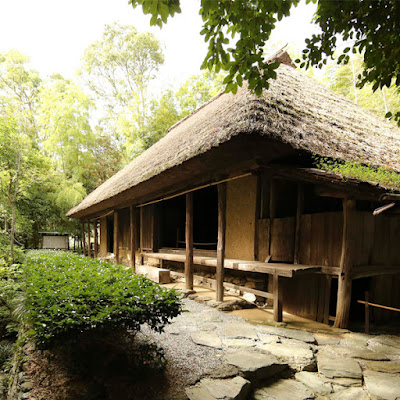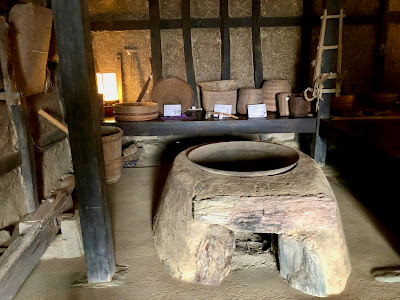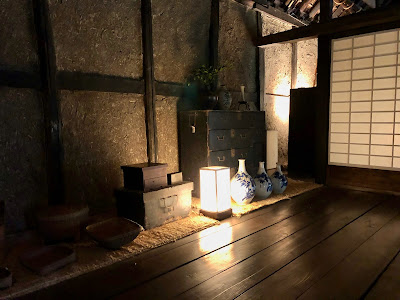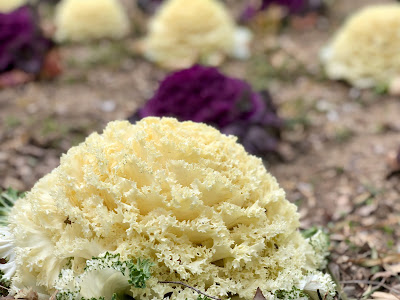 |
| 結婚10周年アートの旅 2023年2月6-12日 2月14日が私達の結婚記念日、私と夫Rは "結婚10周年アートの旅" をしました。 このセクションは主に四国村 (シコクムラ) についてです。 10th Wedding Anniversary Art Trip, 6th of February 6th -12th of February 2023 February 14th was our wedding anniversary, and my husband R and I had a "10th wedding anniversary art trip". This section is mainly about Shikoku Mura. |
 |
| 案内マップ ① - ㉒ の建物を見学しました。(⑪⑯⑰を除く) このセクションは、見晴らし坂、㉓ - ㉗についてです。 Guide Map We visited buildings ① - ㉒. (Excluding ⑪, ⑯, ⑰) This section is about the Observation Hill (Miharashi-zaka) and ㉓ - ㉗. 画像は下記より / This from below★ |
 |
| 見晴らし坂は下の地図の右上に続きます。 'Observation Hill : Miharashi-zaka' continues to the top right of the map below. |
目次/ Contents
1) '見晴らし坂' / 'Observation Hill : Miharashi-zaka'
A. 景色 / Scenery
B. 葉牡丹 / Flowering Kale
3) ㉔下木家住宅 / Shimoki Family House
A. 外観 / Outward Appearance
B. 屋内 / Inside
4) ㉕石組 / Stonework Fountain
5) ㉖添水唐臼 / Water-powered Rice Mill
6) ㉗一宇村の猪垣 / Boar Fence from Ichiu Village
1) '見晴らし坂'
'Observation Hill : Miharashi-zaka'
A. 景色 / Scenery
灯台エリアを離れ、'見晴らし坂' を降りてゆきました。
'見晴らし坂' の名の通り、坂からの景色も素敵でしたし、坂の周囲の植栽も楽しめました。
 |
| 水仙 斜面に水仙がたくさん植えられています。 Narcissus Many narcissi are planted on the hill.  |
Scenery
We left the lighthouse area and headed down 'Observation Hill : Miharashi-zaka'.
As the name 'Observation Hill' suggests, the view from the hill was beautiful, and we also enjoyed the plants surrounding the hill.
 |
| 南を見る 平地は、讃岐平野 (サヌキヘイヤ)、 山並みは、讃岐山脈 (サヌキサンミャク) でしょいうか? Look to the South The flat land is the Sanuki Plain and the mountain range is the Sanuki Mountains, right? |
 |
| 灯台が真っ直線上に見えることに気がつき 撮影しました。 I noticed that the lighthouse was directly above me, so I photographed. |
 |
| 見晴らし坂 / Observation Hill |
B. 葉牡丹 / Flowering Kale
 |
| 葉牡丹または花キャベツ 葉牡丹 (ハボタン) がキャベツ畑ような植え方をされている風景を 初めて見ました。 私にとっては、葉牡丹は鉢植えか、 花壇の一角に植えられている光景が通常です。 Flowering Kale or Ornamental Kale This was the first time I'd seen Flowering Kale planted like a cabbage field. For me, Flowering Kale are usually found in pots or planted in the corner of a flower bed. |
日本語でも、この花を葉牡丹 (ハボタン) と呼んだり、花キャベツとよんだりしますが、英語でも、フラワリング ケール (Flowering Kale) やオーナメント ケール(Ornamental Kale) などの呼び名が複数あります。

同じアブラナ科の野菜ですが、ケールはキャベツのように結球 (葉を丸めること) をせず、大きな葉を花びらのように広げて育ちます。

In Japanese, this flower is called Habotan or flower cabbage,
and in English it has several names, such as Flowering Kale
Although it is also a cruciferous vegetable, kale does not form a head (roll up the leaves) like cabbage, but instead grows with its large leaves spread out like petals.
 |
| 宇宙 1つの花に、1つの宇宙が抱えられているように感じます。 Cosmos It feels as if a single flower holds a single cosmos within it. |
 |
| 珊瑚 珊瑚のようにも見えます。 Coral It looks like coral. |
2) ㉓楮蒸し小屋 / Bark-steaming Hut
 |
| 御伽話の世界 この風景を見た時、タイムスリップしたような 気持ちになりました。 Fairy Tale World When I saw this scenery, I felt as if I had travelled back in time.  ㉓楮蒸し小屋 楮蒸し小屋 (コウゾムシゴヤ) の中に入ることは可能でしたが、 私達はこの小屋はそばまでいかず、遠くから眺めただけでした。 何故か?って...もう、登る気力がなかったからです (苦笑)。 ㉓Bark-steaming Hut It was possible to go inside the Bark-steaming Hut, but we didn't go very close and just looked at it from afar. Why? Because... I didn't have the energy to climb up anymore (Wry Smile). |
下記、四国村サイト、楮蒸し小屋 より
"かつて四国の山間部では和紙の原料となる楮 (こうぞ) や
三椏 (みつまた) の栽培がさかんで、その原料を生かした地域産業として和紙づくりがおこなわれていました。
この小屋は、楮や三椏を蒸すための建物です。
典型的な寄棟造 (※1)・茅葺きの建物ですが、壁も茅で囲ってあるのが特徴的。
中央には石を積み大きなかまどを築き、その上にまるで釣鐘のように大桶が吊るされています。
この大桶を水を張った釜のところまで下げて、原料を蒸していました。
※1:寄棟造・・・建築物の屋根の構造形式のひとつで、四方向に傾斜する屋根面をもつもの"
According to Shikoku Mura website about Bark-steaming Hut,
"Cultivating kozo (paper mulberry) and mitsumata (Edgeworthia chrysantha), the raw materials for washi paper, was once a thriving industry in the mountains of Shikoku, and washi making was a local industry using those raw materials.
This hut was used to steam those raw materials.
The roof is a typical yosemune-zukuri (※1) thatched structure, but more unusually, the walls are also surrounded by thatch.
It has a large stone kamado stove in the center with a large vat hanging above it like a bell.
This vat was lowered over a kettle filled with water to steam the ingredients.
※1: Yosemune-zukuri - A type of hipped roof structure where the surfaces descend from the ridge in four directions."
 |
| かまどと大桶 下記、四国村サイト、楮蒸し小屋 より "かまどと大桶では、切りそろえた楮や三椏を束にして、 釜に立て、上から桶をかぶせて蒸すという、 和紙づくりの最初の工程がおこなわれていました。" Stove and Vat According to Shikoku Mura website about Bark-steaming Hut, "In the steaming process, the first step in making washi paper, bundles of cut kozo and mitsumata were stood up in a pot, then the pot was covered with the vat for steaming." 画像は下記より / This from below ★ |
I saw something similar or the same device at the ⑨Kono Family House, below.
3) ㉔下木家住宅 / Shimoki Family House
A. 外観 / Outward Appearance
 |
| ㉔下木家住宅の美しい屋根 下記、四国村サイト、下木家住宅 より 積雪が多い地域だったため、雪が滑り落ちやすいように 屋根の勾配が急につくられています。 Beautiful Roof of the ㉔Shimoki Family House According to Shikoku Mura website about Shimoki Family House, The region sees heavy snowfall, so the roof is built with very steep sides to encourage the snow to slide off. |
 |
| 横から / From Side |
 |
| ㉔下木家住宅 / Shimoki Family House |
下記、四国村サイト、下木家住宅 より
"徳島県西部に位置する剣山 (つるぎさん) 中腹の一宇 (いちう) 地区から移築された、寄棟造(※1)・茅葺きの民家です。
標高1,000m の急な斜面に、蔵や納屋などと共に建てられていました。
注1:前述に同じ。"
 |
| ㉔下木家住宅 / Shimoki Family House 画像は下記より / This from below ★ |
According to Shikoku Mura website about Shimoki Family House,
"This home with a yosemune-zukuri (*1) thatched roof was built in Ichiu district, on the slopes of Mt.
Tsurugi in western Tokushima Prefecture.
Located on a steep slope some 1,000 meters up, it was built along with a storehouse and barn.
*1: Same as mentioned above. "
B. 屋内 / Inside
下記、四国村サイト、下木家住宅 より
"間取りは「オモテ」(客間)「ナイショ」(寝室)「ニワ」(土間) の3間からなります。
「ニワ」は作業場であり、唐臼や大釜が見られます。
一段高い「ナイショ」にはいろりとかまどがあり、炊事や夜なべ仕事をしました。"
According to Shikoku Mura website about Shimoki Family House,
"The interior has three spaces: the omote (parlor),
naisho (bedroom) and niwa (earthen floor room).
The niwa served as a workspace, and now holds a millstone and large pot.
 |
| 'ニワ' : 土間 'Niwa' : Doma : Earthen Floor Room  大釜 / Large Pot |
 |
| 手前 : 'オモテ' / 客間 奥 : 'ナイショ' / 寝室 Front : 'Omote' / Parlor Back : 'Naisho' / Bedroom |
 |
| 'オモテ' / 客間 'Omote' / Parlor  |
"展示されている主屋は上屋が梁ゆき3間 (5.4m)、桁ゆき6間の広さがあることから、「本三六(ほんさんろく)の家」と呼ばれています。"
According to Shikoku Mura website about Shimoki Family House,
"The main house on display is called Honsanroku no Ie, because the upper floor is san-ken (5.4 meters) long and roku-ken (10.8 meters) wide."
 |
| 梁 立派な梁で、尚且つ複雑な構造に見えます。 下記、四国村サイト、下木家住宅 より "天井の梁は上屋梁 (じょうやばり)、下屋梁 (げやばり) に穴をあけ一本の柱を通す「おとしこみ方式」で組まれており、 この方式は建物があった一宇地区の大工が 元祖といわれています。" Beams It has impressive beams and appears to have a complex structure. According to Shikoku Mura website about Shimoki Family House, "The ceiling beams are arranged in an otoshikomi style, with a single pillar running through holes bored in the upper beams and lower beams. The Ichiu region is said to be the origin of this style. |
 |
手前 : 'ナイショ' / 寝室 奥 : 'オモテ' / 客間 Front : 'Naisho' / Bedroom Back : 'Omote' / Parlor |
 |
| 'ナイショ' / 寝室 'Naisho' / Bedroom |
 |
| 床下 下記、四国村サイト、下木家住宅 より "冬の間はなかなか外に出られない環境だったため、 床下に大小数個の穴を掘り、こんにゃく玉や芋などの 食料を貯蔵していました。" 現在の床下収納庫ですね。 Subfloor According to Shikoku Mura website about Shimoki Family House, "Since the environment kept people indoors for most of the winter, several pits of various size were dug beneath the floor to store food like konjac balls and root vegetables." It is currently the underfloor storage space, isn't it? |
4) ㉕石組 / Stonework Fountain
 |
| ㉕石組, 1977 作 : 彫刻家、流 政之 (ナガレマサユキ/ 1923 -2018) 私達が訪れた日は、水回りの工事をしていました。 '㉕石組' と '㉚染が滝' (ソメガタキ) には水がありませんでした。 ㉕Stonework Fountain, 1977 By a sculptor, Masayuki Nagare (1923 -2018) On the day we visited, construction work was being carried out on the plumbing. There was no water in '㉕Stonework Fountain' and '㉚Somegataki Waterfall'.  |
下記、四国村サイト、石組より
"民家の土台石を組み合わせて作られた流政之の作品。
湧き出るように流れる水が「染が滝」へと続き、新緑や紅葉も映える心和む場所です。"
 |
| 通常の石組 Normal Stonework Fountain 画像は下記より/ This from below ★ |
According to Shikoku Mura website about Stonework Fountain,
"Masayuki Nagare created this work by combining foundation stones from old homes.
The water, bubbling up as if from a spring, leads the way to Somegataki Waterfall, a peaceful place of spring green and autumn color."
 |
| 工事中 ここは、'㉚染が滝'の滝壺周辺 。 通常なら、'石組'から湧き出た水は、ここに落ちてきます。 Under Construction This is the area around the basin of Somegataki Falls. Normally, the water gushing out from the Stonework Fountain falls here. |
 ㉖添水唐臼 (ソズカラウス) 下記、四国村サイト、添水唐臼より "1955年頃まで徳島県美馬郡つるぎ町(旧一宇村)に 残っていたものを再現" ㉖Water-powered Rice Mill :' Souzu-karausu' According to Shikoku Mura website about Water-powered Rice Mill : 'Souzu-karausu', |
| "Replica of an original that stood in Tsurugi, Mima, Tokushima Prefecture until 1955."  |
"穀類を精白するための装置として使われていた小屋。
'添水'(ソズ)とは、もともと田畑を荒らす鳥獣をおどす道具で、竹筒と水を利用して自動で石を鳴らし、音を出していました。
(現在は音色を工夫し、風情を感じる 'ししおどし' として使われています。)
これと同じ仕組みで、石を打つ部分に杵をつけ、水力によって自動的に穀物をつくようにしたものが添水唐臼 (ソズカラウス)です。
水が少ない地域で個人または近所が共同で利用していたもので、俗に“ソウズ”と呼ばれ、簡単に精白ができる貴重な道具でした。"
ししおどし (鹿威し)は、風流な庭を表現する1つの素材という意味合いが先行してしまいますが、本来の目的は、鳥獣をびっくりさせることなのだと、思い出させてくれました。
 |
| いつもなら、カッコーン!という 'ししおどし' の音が 響き渡るのでしょう。 残念ながら、今日は水が止まっているので、聞けませんでした。 Usually, the sound out would echo through the air. Unfortunately, the water was turned off today, so I couldn't hear it. |
According to Shikoku Mura website
"This hut was used as for milling grains.
A sozu was originally a way to scare away birds and animals, that might damage fields, using a bamboo tube and water to automatically hit a stone and make a sound.
Nowadays, similar items have been adapted for better sound and are used for ambience : Shishi-odoshi.
A sozu karausu (water-powered rice mill) uses a similar concept to power the mill, with a pestle attached to the bamboo where it hits the stone to automatically pound grain using waterpower.
Similar devices were used by individuals or shared by communities in areas where flowing water was scarce, and was commonly called simply sozu.
It was a valuable tool to ease rice hulling."
Although Shishi-odoshi is primarily thought of as an element that creates an elegant garden, it reminds me that its original purpose was to frighten birds and animals.
 |
| 横からの添水唐臼 右の石は、㉗一宇村の猪垣です。 The Mill from the Side The stones on the right are ㉗Boar Fence from Ichiu Villagee. |
6) ㉗一宇村の猪垣
Boar Fence from Ichiu Village
 |
| 小屋は、 ㉖添水唐臼 右の石の列が㉗一宇村の猪垣 いつもなら、石の川には水が流れているのだと思います。 The hut is ㉖Water-powered Rice Mill. The row of stones on the right is ㉗Boar Fence from Ichiu Village. I think that normally there is water flowing in the stone river. |
案内板を読み、四国村には、3つの猪垣(シシガキ)が復元されていると知りました。
私達が歩いてきたルートにも、他の猪垣があったのかもしれませんが、気がつきませんでした。
After reading the guide board, I found out that three boar fences (shishigaki) have been restored in Shikoku Mura.
There may have been other fences along the route we walked, but we didn't notice them.
 |
| ㉗一宇村の猪垣 ㉗Boar Fence from Ichiu Village  |
 |
| お地蔵様? 通常なら、ここへも水が流れているのだと思います。 Jizo Statue? Normally, I think water would be flowing here too. |
 |
| この道を下って、㉘久米通賢旧宅を目指します。 Go down this hill and head towards ㉘Kume Tsuken Residence. |
次のセクションは、登り道の右 (東側) にあった建物についてです。
The next section is about the buildings that were on the right (east) side of the route.





















0 件のコメント:
コメントを投稿